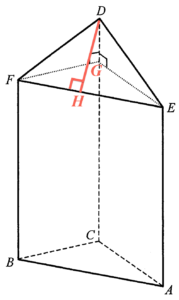- By applying Heron’s formula to $\Delta ABC$, we have
$\begin{array}{rcl}
s & = & \dfrac{AB + BC + AC}{2} \\
& = & \dfrac{9 + 5 + 6}{2} \\
& = & 10 \text{ cm}
\end{array}$Therefore, the area of triangular base $ABC$
$\begin{array}{cl}
= & \sqrt{s(s-AB)(s-BC)(s-AC)} \\
= & \sqrt{10(10-9)(10-5)(10-6)} \\
= & \sqrt{200} \\
= & 10\sqrt{2} \text{ cm}^2
\end{array}$Hence, the volume of the souvenir $ABCDEF$
$\begin{array}{cl}
= & 10\sqrt{2} \times 20 + \dfrac{1}{3}\times 10\sqrt{2} (23-20) \\
= & 200\sqrt{2} + 10\sqrt{2} \\
= & 210\sqrt{2} \text{ cm}^3
\end{array}$ - Add a point $G$ on $CD$ such that $FG\perp CD$. Add a point $H$ on $EF$ such that $DH\perp EF$.

Note that $FG=BC=5\text{ cm}$, $GE=CA=6\text{ cm}$ and $EF=AB=9\text{ cm}$. In $\Delta DFG$,
$\begin{array}{rcl}
DF^2 & = & DG^2 +FG^2 \\
DF & = & \sqrt{3^2 + 5^2} \\
DF & = & \sqrt{34} \text{ cm}
\end{array}$In $\Delta DEG$,
$\begin{array}{rcl}
DE^2 & = & DG^2 + GE^2 \\
DE & = & \sqrt{3^2 + 6^2} \\
DE & = & \sqrt{45}\text{ cm}
\end{array}$By applying the cosine law to $\Delta DEF$, we have
$\begin{array}{rcl}
\cos \angle DFE & = & \dfrac{DF^2 + EF^2 – DE^2}{2(DF)(EF)} \\
\cos \angle DFE & = & 0.666\ 938\ 943 \\
\angle DFE & = & 48.168\ 751\ 76^\circ \\
\angle DFE & \approx & 48.2^\circ
\end{array}$Note that the shortest distance from $D$ to $EF$ is $DH$. In $\Delta DFH$,
$\begin{array}{rcl}
\sin \angle DFH & = & \dfrac{DH}{DF} \\
DH & = & DF\sin \angle DFH \\
DH & = & 4.344\ 714\ 399 \\
DH & = & 4.34 \text{ cm}
\end{array}$ - Note that the area of the thin rectangular metal plate
$\begin{array}{cl}
= & 5 \times 4 \\
= & 20 \text{ cm}^2
\end{array}$The area of $\Delta DEF$
$\begin{array}{cl}
= & \dfrac{1}{2} \times EF \times DH \\
= & 19.551\ 214\ 8 \text{ cm}^2 \\
< & 20 \text{ cm}^2 \end{array}$Therefore, the thin rectangular metal plate cannot be fixed onto the triangular surface $DEF$.
2007-I-16
Ans: (a) $10\sqrt{2}\text{ cm}^2$, $210\sqrt{2}\text{ cm}^3$ (b) $\angle DFE=48.2^\circ$, $4.34\text{ cm}$ (c) No

